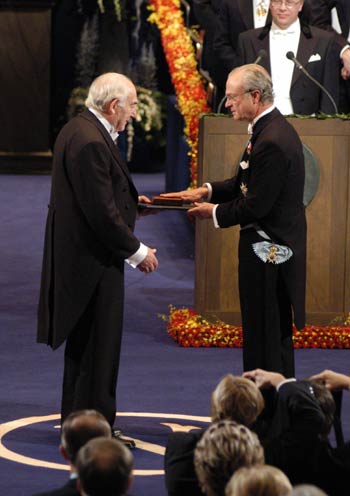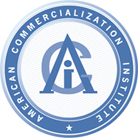|

See a Video of the Interview
11 min.
Vitaly L. Ginzburg receiving his Nobel Prize
from His Majesty the King at the Stockholm Concert Hall. 2003
Photo: Hans Mehlin, Nobel e-Museum
Russian scientists develop
new TB, AIDS, other vaccines

Russian scientists accomplish the
development of fundamentally new TB, brucellosis, typhoid, dysentery,
AIDS and other vaccines, academician Viktor Kabanov said at the session
of the Presidium of the Russian Academy of Sciences on Tuesday.
"Synthetic vaccines have fundamental difference from ordinary ones using
weakened pathogens. Synthetic vaccines are based on a special polymer,
Polyoxidonium, selected by Russian specialists. It reinforces immunity
of the organism. If an antigen of this or that pathogen is chemically
connected to this polymer it will turn not into a simple adjuvant but a
vaccine to prevent this disease," the scientist said. "This is
especially valuable in the case of AIDS in order not to administrate
pathogens of this dangerous disease into human organism," Kabanov
stressed.
"The first unique synthetic vaccine was developed by Russian scientists
and has been successfully used for seven years already. This is Grippol
vaccinated to 50 million people," academician Kabanov said.
"If common vaccines has a 60-percent effect, synthetic Grippol protects
90 percent of vaccinated people," said academician Rem Petrov, a creator
of the new vaccines. Other vaccines tested on animals protect them even
from fatal doses of relevant bacteria and viruses, Viktor Kabanov noted.
Polyoxidonium is patented in the US and many European countries
academician Petrov said. According to him, 10-15 years are needed to
find another synthetic bio-polymer suitable for vaccines and to put it
into practice. Creators of the new generation of vaccines were awarded
with the Russian State Prize in 2002.
|
OUR PRIMARY GOAL
The goal of our center is to turn Russia into a responsive
and supportive ally in the US global war against terrorism through the creation
of a tight commercialization bond of the Russian (and CIS) scientific hi-tech
community and their great innovative & inventive technological potential
with the US R&D community, the American industry and the high tech market
infrastructure of the United States.
Russia currently lies divided between two
opposing sides: the intellectual, cultural, high-tech elite community of
business people and scientists with mentalities similar to those of the American
people and the old militaristic, pro-communist world sympathizing with and who
might potentially support pro-terrorist countries. Russia leads the world with a
great number of scientists in nuclear, chemical and biological research who can
be potentially persuaded and lured by terrorists, to build weapons of mass
destruction for them - weapons that might be used against our soldiers, and
against the United States. It is vitally important to the safety of the United
States to have Russia on our side, to assist the pro-American Russian scientific
community, and to help them gain more power in Russia against our enemies. By
creating and growing an innovative technology commercialization partnership
between Russia and the United States, we will make Russia a true ally in our
fight against terror.
"Today, Russia possesses approximately 20,000 nuclear
weapons and enough weapons-grade material to fabricate over 60,000 more. Not
including the United States, Russia possesses approximately 95 percent of the
world's nuclear weapons and weapons-grade material, a testimony to the great
resources and effort that both sides devoted in waging the cold war. These
weapons and material are stored in literally hundreds of sites across Russia's
11 time zones. Making this problem even more disconcerting is the fact that
Russia is unable to reliably account for its huge stock of warheads and
materials, having inherited a sub-standard accounting system from the
totalitarian Soviet state."
"There are over 20,000 scientists and technicians
in the former Soviet Union that are considered proliferation risks."
"Russian proliferation of Weapon of Mass
Destruction related goods, technologies, and know-how to Iran represents a clear
threat to national security."
In addition to preventing proliferation of Russian
chemical and biological weapon scientists and technologies to US enemies and in
addition to creating jobs and companies in the United States and economically
invigorating the United States, this collaboration will also be focused on
technologies that solve main problems of the United States in the matters of
National Security, Life Sciences and Homeland Security:
- Homeland Security:
technologies for early detection and protection against terror threats
(personal, explosive, nuclear, chemical and biological detection and prevention
etc.);
- Human Health: technologies for diagnosis and treatment of life
threatening and most dreaded diseases;
- Environmental Protection: energy
preserving and environmentally clean technologies;
- New Market Initialization:
"golden seeds" for the emerging markets (biotech, nano-technology, IT,
telecom, etc.)
The Russian scientific community already collaborates with
the United States R&D community, and there are many International programs
that currently try to address the non-proliferation issue of Russian weapons and
R&D and that try to stabilize democracy in Russia. However all these
programs have only been capable of meeting all of these problems half-way: they
redirect Russian Institutions from military research to civilian research, but
only for the period of time while American funding is available. None of these
programs have successfully been able to create a self-sufficient self-sustaining
commercialization / research ecology and there is no guaranty that these
Institutes and these scientists will not return back to military research and
will not be enlisted by pro-terrorist countries just after the American funding
ends. Today, the American non-proliferation programs are only feeding and
sustaining, but are not linking and involving the Russian research
infrastructure to a great market and the high tech industrial infrastructure of
the United States.
The most reliable way to involve Russia into a long-term
alliance with the United States is through the creation of a comprehensive
commercialization process of linking Russian Research potential with the
established US market and the US Industrial Infrastructure.
The Center has started by targeting Russian applied research to the
perspectives of the American market needs. It connects and introduces the
Russian R&D teams to the American needs and partners, creates US companies
to receive the Intellectual Property, the products and the Russian scientists,
provides access to the rigorous ACI commercialization processes to the new
"US" technology, and negotiates and figures out ways to make
remunerate the Russian Institute and Russia for their cooperation and their
original funding of the technology.
|




